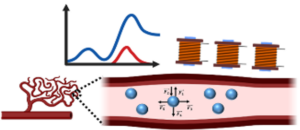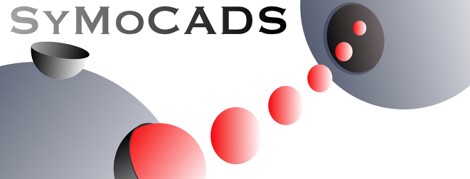Project P4
P4: Forces, Limitations, and Concepts for SPION Steering

Motivation and state of the art:
The propagation of SPIONs in magnetic steering systems is not only determined by diffusion, background flow, and magnetic forces, but also by other forces, including electrostatic forces caused by polarization of the particle surface1,2, friction forces, and forces related to the particle surface-volume ratio and other energy gradients3. Furthermore, as forces are a consequence of energy gradients, energy maxima and minima as a function of the inter-particle distance are crucial for how multiple SPIONs form agglomerates, especially in the presence of external fields4-6. In practice, these agglomerates should be stable and not too large to avoid blockage of vessels3. For simplicity, in the following, we will employ the commonly used term “SPION steering”, although it is understood that usually SPION agglomerates are steered. The superposition of multiple forces and energy gradients affects the ability to steer SPIONs in highly branched vascular systems (i.e., the considered MC channel). In particular, the superposition of attractive and repulsive forces impacts the size of the agglomerates that individual SPIONs form, the tendency for accumulation of SPIONs in undesired locations, and the distance over which effective steering is possible. For example, accumulation of SPIONs below the steering electromagnet (coil) was experimentally observed even when the magnet was switched off7. This phenomenon was not expected and is not fully understood, yet. It is speculated that dielectric and frictional forces are responsible. An undesired accumulation of SPIONs is problematic as it leads to a locally increased magnetic permeability, which affects the magnetic field distribution. Although this retroaction is typically ignored in the literature8,9, our preliminary work10 indicates that it may cause a reduction of the magnetophoretic force by a factor of five. Increasing the magnetic field strength to compensate for this effect is not a viable option, as this will only intensify the accumulation of SPIONs. Therefore, for effective SPION steering, unwanted accumulation is to be avoided. Furthermore, in existing experimental systems11,12, a single steering coil is placed close to the MC channel. However, for the actual application (e.g., targeted drug delivery), effective steering from a comparatively large distance is required. Here, our preliminary work on Halbach arrays13,14 indicates that limitations in steering performance can be overcome by applying weaker but distributed magnetic forces.
Objectives:
This project has the following objectives: (i) The magnitudes and distance dependencies of all attractive and repulsive forces and energy gradients relevant for SPION steering will be analyzed and compared. In addition, the impact of the superposition of the inter-particle distance dependent forces on the size distribution of SPION agglomerates will be studied. (ii) The causes and consequences of undesired accumulation will be investigated, and its negative impact on the steering performance due to retroaction will be assessed. (iii) Based on the insights gained, new approaches for preventing undesired accumulation will be developed. To this end, the application of weaker but distributed steering magnets, arranged as an array, will be investigated. Similar to the concept of linear reluctance motors, sequentially driven multi-dimensional coil arrays15-18 will be considered, as they provide more degrees of freedom for SPION steering and avoid fixed locations of high permanent energy density, which are suspected to be the cause of undesired SPION accumulation. For these coil arrays, optimal arrangements and sequential driving schemes will be investigated. This is expected to enable effective steering over larger range. (iv) To allow navigation of SPIONs (or rather of their agglomerates) through large diameter vessels, three-dimensional (3D) steering is needed. Thus, we will derive the theoretical limits of 3D steering in light of Earnshaw’s theorem19-24, which states that 3D magnetic levitation via static magnetic fields is not possible. The relevant forces and limitations in SPION steering unveiled in this project will be exploited for development of lumped-parameter models and steering algorithms in P5 and be experimentally verified and refined based on the physical models developed for the vascular and tissue structures of tumors as well as the surrounding vessel system in P6.
References
1.Derjaguin and L. Landau, “Theory of the Stability of Strongly Charged Lyophobic Sols and of the Adhesion of Strongly Charged Particles in Solutions of Electrolytes,” Prog. Surf. Sci., vol. 43, pp. 30-59, 1993.
2.Verwey, J. Overbeek, and K. van Nes, “Theory of the Stability of Lyophobic Colloids: the Interaction of Sol Particles Having an Electric Double Layer,” Elsevier Publishing Company, 1948.
3.Unterweger, „Multimodal Superparamagnetic Iron Oxide Nanoparticles as a Safe Contrast Agent for Magnetic Resonance Imaging and Magnetic Drug Delivery,“ Dissertation, Friedrich-Alexander-Universität Erlangen-Nürnberg (FAU), Erlangen, 2018.
4.Baun and P. Blümler, “Permanent Magnet System to Guide Superparamagnetic Particles,” J. Magnetism and Magnetic Material, vol. 439, 2017, doi: 10.1016/j.jmmm.2017.05.001.
5.Blümler, “Magnetic Guiding with Permanent Magnets: Concept, Realization and Applications to Nanoparticles and Cells,” Cells, vol. 10, 2708, 2021 doi: 10.3390/cells10102708.
6.B. Mathieu and S. Martel, “Magnetic Microparticle Steering Within the Constraints of an MRI System: Proof of Concept of a Novel Targeting Approach,” Biomed Microdevices, vol. 9, pp. 801-808, 2007.
7.M. Bartunik, M. Lübke, H. Unterweger, C. Alexiou, S. Meyer, D. Ahmed, G. Fischer, W. Wicke, V. Jamali, R. Schober, and J. Kirchner, “Novel Receiver for Superparamagnetic Iron Oxide Nanoparticles in a Molecular Communication Setting,” in Proc. 6th ACM Int. Conf. Nanosc. Comp. Commun., pp. 1-6, 2019.
8.Gitter and S. Odenbach, „Investigations on a Branched Tube Model in Magnetic Drug Targeting-Systematic Measurements and Simulation,“ IEEE Trans. Magn., vol. 49, pp. 343-348, Jan. 2013.
9.Zafar, et al., “Performance Analysis of Magnetic Nanoparticles During Targeted Drug Delivery: Application of OHAM,” Comp. Model. Eng. Sci., vol. 130, pp. 723-749, 2022.
10.Thalmayer, S.Zeising, and G.Fischer, “Reduced Steering Performance in Magnetic Drug Targeting Induced by Shielding Arising from Accumulation of Particles,” Curr. Dir. Biomed. Eng., De Gruyter, vol. 8, part 2, pp 560-563, Sep.
11.Wicke, H. Unterweger, J. Kirchner, L. Brand, A. Ahmadzadeh, D. Ahmed, V. Jamali, C. Alexiou, G. Fischer, and R. Schober, „Experimental System for Molecular Communication in Pipe Flow with Magnetic Nanoparticles,“ IEEE Trans. Mol. Biol. Multi-Scale Commun., vol. 8, pp. 56-71, Jun. 2022.
12.Unterweger, J. Kirchner, W. Wicke, A. Ahmadzadeh, D. Ahmed, V. Jamali, C. Alexiou, G. Fischer, and R. Schober, “Experimental Molecular Communication Testbed Based on Magnetic Nanoparticles in Duct Flow,” in Proc. IEEE 19th Int. Workshop Sig. Proc. Adv. Wirel. Commun., pp. 1-5, Jun. 25–28, 2018.
13.S. Thalmayer, S. Zeising, G. Fischer, “Reduced Steering Performance in Magnetic Drug Targeting Induced by Shielding Arising from Accumulation of Particles”, Curr. Dir. Biomed. Eng., De Gruyter, vol. 8, pp 560-563, 2022.
14.A. Thalmayer, S. Zeising, G. Fischer, and J. Kirchner, “Steering Magnetic Nanoparticles by Utilizing an Adjustable Linear Halbach Array,” in Proc. Kleinheubach Conf., 2021
15.Shapiro, S. Kulkarni, A. Nacev, S. Muro, P. Stepanov, and I. Weinberg, „Open Challenges in Magnetic Drug Targeting,“ Interdiscip. Rev. Nanomed. Nanobiotechnol., vol. 7, pp. 446–457, 2015.
16.Kee, H. Lee, and S. Park, „Optimized Halbach Array for Focused Magnetic Drug Targeting,“ J. Magn. Magn. Mater., vol. 514, 167180, Nov. 2020.
17.Van Durme, G. Crevecoeur, L. Dupré, and A. Coene, „Model-based Optimized Steering and Focusing of Local Magnetic Particle Concentrations for Targeted Drug Delivery,“ Drug Delivery, vol. 28, pp. 63-76, 2021.
18.Wei, J. Yongliang, X. Zheng, L. Ming, and L. Cong, „Application and Evaluation of Halbach-like Magnet Arrays to Magnetic Drug Targeting,“ Adv. Mat. Research, vol. 320, pp 118-123, Aug. 2011.
19.Earnshaw, “On the Nature of the Molecular Forces which Regulate the Constitution of the Luminiferous Ether,” Trans. Camb. Philos. Soc., vol. 7, p. 97, 1848.
20.McNeil, R. Ritter, B. Wang, M. Lawson, G. Gillies, K. Wika, E. Quate, M. Howard, and M. Grady, “Characteristics of an Improved Magnetic-implant Guidance System,” IEEE Trans. Biomed. Eng., vol. 42, pp. 802-808, 1995.
21.Witzel, “Magnetic Levitation,” IEEE Instrum. and Measur. Mag., vol. 13, pp. 39-41, 2010.
22.Kun-Xi, Z. Pei, R. Wei-Min, and Y. Hai-Yu, “Novel Magnetic Spring and Magnetic Bearing,” IEEE Trans. Magnetics, vol. 39, pp. 559-561, 2003.
23.Sinha, “Electromagnetic Suspension Dynamics & Control”, P. Peregrinus Ltd., 1987.
24.Küstler and I. Nemoianu, “Theoretical and Experimental Evaluation on a Counterintuitive Diamagnetically Stabilized Levitation Setup with Permanent Magnets,” in Proc. 8th Int. Symp. Adv. Top. Electr. Eng., pp. 1-4, 2013.
